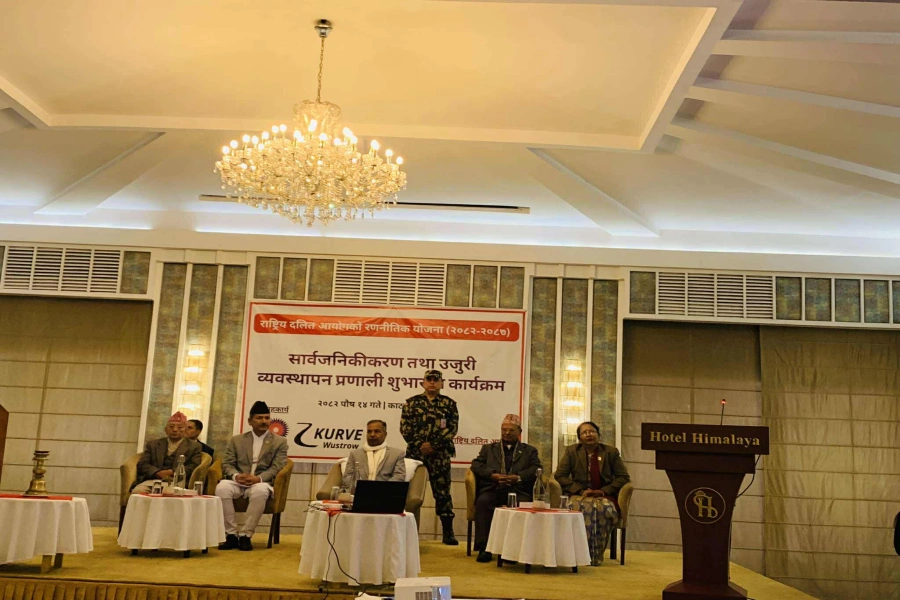Bitcoin is banned in Nepal because it is misunderstood. Maybe, it got more attention as a ticket to get rich quickly or even many confused it for a Ponzi scheme where innocent investors lose their life savings. Bitcoin, however, is based on a sound economic theory and can teach us a thing or two about organizing civilization for the digital age.
French Romantic writer and politician Victor Hugo once said, “No army can stop an idea whose time has come.” The phrase captures a fundamental reality of genuine radical political movements arising from the people’s dissatisfaction with the status quo’s handling of socio-economic development in the age of social media. It starts with people expressing discontent on social media that transforms into riots to force changes in areas like the ECONOMY and human rights. Such violent uprisings can be avoided by taking the protestors’ demands seriously, but an attempt to quell such demonstrations and public outrage could turn the uprising quickly into a revolution, pushing aside everything that stands in its path because the protests are always against a morally bankrupt system. In recent history, we saw a ten-year-long armed struggle that ended with a violent uprising in 2006, but people's lives have not improved that much economically and the country has become a banana republic - let us unpack.
No one took the Maoists seriously when they started the ‘people’s war’ in 1996 to establish a people’s republic. The Maoists were initially ridiculed and even laughed at, but by 2008, the country had already become a republic. Even though the odds were against them, the Maoists won because they had a radical IDEA about disrupting the status-quo to modernize Nepali society that had remained somewhat feudal for hundreds of years. Sadly, the Maoists failed to deliver on their promises and ended up implementing an outmoded governance system with other mainstream political parties. Only a few lawmakers from the Rastriya Prajatantra Party opposed the whole sham.
It is now widely accepted that the federal structure of Nepal has not been able to deliver prosperity to everyone as promised during the revolution. There is no sign that things are likely to get better in the future. The republic could end up collapsing because the bloated bureaucracy and parliament required to sustain federalism have put a heavy burden on the taxpayer’s money. Implementing such a system in the digital world of the 21st Century was a big misstep. Federalism was a viable option to replace the highly centralized systems used by the Rana Oligarchy or even the slightly reformed Panchayat system.
The digital revolution has radically transformed our society in the last 25 years. The creative capitalist system has almost displaced ideologies and political systems that were born in the first and the second industrial revolutions when a factory proletariat was the principal antagonist of the factory owner. The Marxist ideology germinated during that time and predicted or even showed a way for impoverished peasants to oppose feudal and semi-feudal landowners. Marxist political ideas were somewhat relevant, if not pragmatic, to free the disoriented proletariats from the oppression inflicted upon them by the industrial bourgeoisie in 18th Century Europe.
The Marxist ideology also gained wider popularity in Nepal after the reestablishment of democracy in 1990 because most parts of the country including the outskirts of the Kathmandu Valley had remained agrarian society that was still feudal in character due to the isolationist policy taken by the Rana Oligarchy and later by the Panchayat system. During that time, Nepal missed the first and the second industrial revolutions. The new democratic Nepal in the 90s saw the liberalization of the economy, education, and media triggering people to migrate to the cities seeking better employment opportunities and quality higher education. The majority that migrated to the cities were not educated and were forced to work in the factories under inhumane conditions.
Bitcoin's rise from $0.01 to $11,000

Extreme centralization of political power, bad governance, Nepali Congress’s inability to effectively implement the neo-liberal economic policies, massive exploitation of factory workers, and misuse of the police by the bourgeoise to quell the objections of the working class contributed to creating a favorable environment for the Maoist-led ‘people’s war’. The Maoist movement successfully transformed the consciousness of Nepali society. The people became aware of their political, economic, religious, free speech, and other rights.
After the uprising of 2006, the monarchy was abolished in 2008. Unfortunately, the process of formulating the new constitution dragged on for too long. By then, the world had already entered the era of the fourth industrial revolution. The political parties failed to realize that the political setup and governance system they had envisioned for Nepal was not going to work for the highly globalized digital economy. In 20 years, from 1996 to 2016, Nepal rapidly transformed into a digital society from an agrarian society. The constitution came too late or perhaps the digital revolution was happening at breakneck speed. To make the matter worse, contrary to the general public’s expectation, Nepal ended up transforming into a neo-feudal society with wealth ever more concentrated in bureaucracy, political parties, the state security machinery, and the cartels. The neo-bourgeois-crafted hyperinflation and lack of employment opportunities in the country have forced the neo-proletariat to migrate to work in factories with even harsher working conditions in the Middle East.
The opinion piece titled ‘Industry 4.0’ that I co-authored with the late Saroj Devkota, former vice chairman of the High-Level Commission for Information Technology (Government of Nepal), published in Republica in October of 2016 tried to highlight the government’s lack of foresight on the coming industrial revolution.The article reasoned that the Fourth Industrial Revolution has the potential to significantly improve the quality of the lives of the Nepali people. Also, the piece suggested it will be futile for Nepal to depend on remittances in the long run, even though remittance at that time was nearly 10 times higher than foreign aid and 2.5 times larger than total exports. Furthermore, the article also suggested the government attack the imminent challenges by immediately upgrading the skill set of the populace to prepare them for the digital revolution as well as, in the long term, overhaul the education system of the country because 65 percent of the children entering primary school would end up working in jobs that don’t exist in the current context.
The political parties failed to see the digital revolution sweeping the world because they were blinded by the success of their political victory and amassing wealth. Nepali Congress, after having lost its soul after failing to implement the neo-liberal economic policies, too, danced to the tune of the Maoists. The neo-Marxist order that included Nepali Congress, UML, the Maoists, and other fringe parties went ahead and implemented a system fit for the 18th Century.
None of the anti capitalistic ideologies like MARXISM, representative democracy and centralized governance, currently, retain the same relevance that they had at an earlier stage of capitalist development in the 18th Century. Despite being a brilliant theory of material preconditions for socialism, Marxism stagnated theoretically as it did not evolve to impel humanity into a movement for revolutionary social change. Marxism’s economic insights belonged to an era of emerging factory capitalism in the 18th Century and does not fit in its original form for the era of the mobile internet, social-medial, globalization, cryptocurrency, and the metaverse.
The Ministry of Finance is still engaged in madness by taking loans from donor agencies and international financial institutions, forgetting that the loans will have to be paid in the future. The government does not have a clue that it lacks the necessary brainpower to use the loans productively to strengthen the tourism sector or create a favorable environment for businesses to increase exports. Millennials already know that the Ministry of Finance is where the country should employ its brightest who have graduated from Harvard University, ivy league universities, and other equivalents. Only God can save the banana republic unless the Ministry of Finance is filled with the crème dela crème.
Now in 2022, the country is still overly dependent on remittances. Besides, the flawed federal structure and almost obsolete representative democracy, the MISMANAGEMENT of money by the Nepal Rastra Bank (NRB) coupled with more than a decade of bad governance unleashed by the neo-Marxist order have created a desperate situation for the population as a whole. It seems as though nothing is working properly because the youth (wealth) of the country are still leaving for foreign soil every day in hordes to earn MONEY or to invest in good education that will earn them more money. The Government of Nepal should be worried about the crème de la crème leaving the country and be really, really worried because most of them will never return. Instead, the government is worried about cryptocurrencies like Bitcoin.
Bitcoin is banned in Nepal because it is misunderstood. Maybe, it got more attention as a ticket to get rich quickly or even many confused it for a Ponzi scheme where innocent investors lose their life savings. Bitcoin, however, is based on a sound economic theory and can teach us a thing or two about organizing civilization for the digital age. Bitcoin grew on the major pillars of the neo-liberal market economy, such as liberalization, deregulation, and privatization, but it is more enthusiastically accepted as a currency by economists of the Austrian School - a school of economic thought that originated in Vienna in the late 19th century and whose method is rooted in the analysis of the actions of individuals.
Austrian school economists believe money emerges from competition between several mediums of exchange that emerge with technological advancement. The most cutting-edge as well as the most accepted among the many will become money and the rest co-exist as quasi-money (secondary mediums of exchange). The government’s monopoly on money creation and supply, if coupled with a non-accommodative attitude toward new mediums of exchanges will stifle innovation. This regressive attitude will not only stop money from evolving but make our money unsuitable for the global digital economy. The Nepali currency is as good as paper outside of Nepal, while Bitcoin is appreciated in almost all liberal democracies around the world.
Governments create demand for fiat currency by declaring it a legal tender and forcing everyone to accept it as payment to settle debts. The Austrian School economists believe that an increase in the money supply or an expansion in credit will inevitably lead to price increases and economic stability and that inflation is not an increase in the prices of goods and services, but merely an increase in the money supply. There are two approaches to deflation: through technological progress or decreasing the money supply. Since thoughtless deflation could end up creating bigger problems in the long run, deflation arising from technological progress is preferred because it is usually not harmful to economic growth. So, they advocate a fixed money supply like Bitcoin.
People usually protest or only notice when the price of goods increases sharply. People do not care when the price of goods rises steadily over time for they accept it to be normal (inflation). Inflation, in reality, is not the increase in the price of goods but the value of money decreasing due to monetary expansion (increase in the money supply). Things become expensive because of price inflation (decrease in the value of money). Since the value of money decreases rapidly, people are forced to invest in more value-preserving assets like real estate, creating asset inflation and causing their (e.g. real-estate) values to grow at rates faster than the broader economy. Many are indirectly forced to spend money quickly to buy luxury goods or go on vacation in foreign countries as the money’s purchasing power drops every day. If wages don’t rise as fast as inflation, people are technically getting paid less every month because the purchasing power of money is decreasing rapidly even though the salary remains the same or increases slightly. This is a robbery, not by the employers, but by the state.
Bitcoin is not a panacea, but it provides a peek into how civilization will/can be organized in the future. Bitcoin is more ideological in nature for now because the people who champion it are more enthusiastic about removing governments’ hands from the monetary reigns. Bitcoin is a leap forward in the technology of money because it is decentralized as in it does not come from nor is it controlled by, a centralized source as no bank and credit card companies acting as intermediaries. Bitcoin is perfectly scarce, having a 21-million-unit limit which also means it is non-inflatable money in a world where wealth is continuously stolen by hyperinflation. Bitcoin cannot solve the chaos in the world economy but can provide pointers for course correction.
Time has shown that the radical Maoist movement failed to deliver miserably. Only a handful benefited.The Maoists fought against the highly centralized and overtly hierarchical governance structure of Nepal but ended up creating a highly dysfunctional system that put a heavy burden on the taxpayers’ money. The political power and money are even more centralized now. The Nepal Rastra Bank is still directly or indirectly responsible for the economic desperation faced by the people of Nepal, perhaps due to the continuous political interference.
The Bitcoin revolution is different. Anyone with internet access can connect to the Bitcoin revolution, and even own a piece of it. The Wall Street Journal defined Bitcoin as the greatest financial innovation in 500 years. Likewise, the Bank of England believes the Bitcoin protocol will be as disruptive as the internet protocol.
If Nepal is to avert the fate of the Soviet Union, calibrating the republic for the fourth industrial revolution is a must.





































